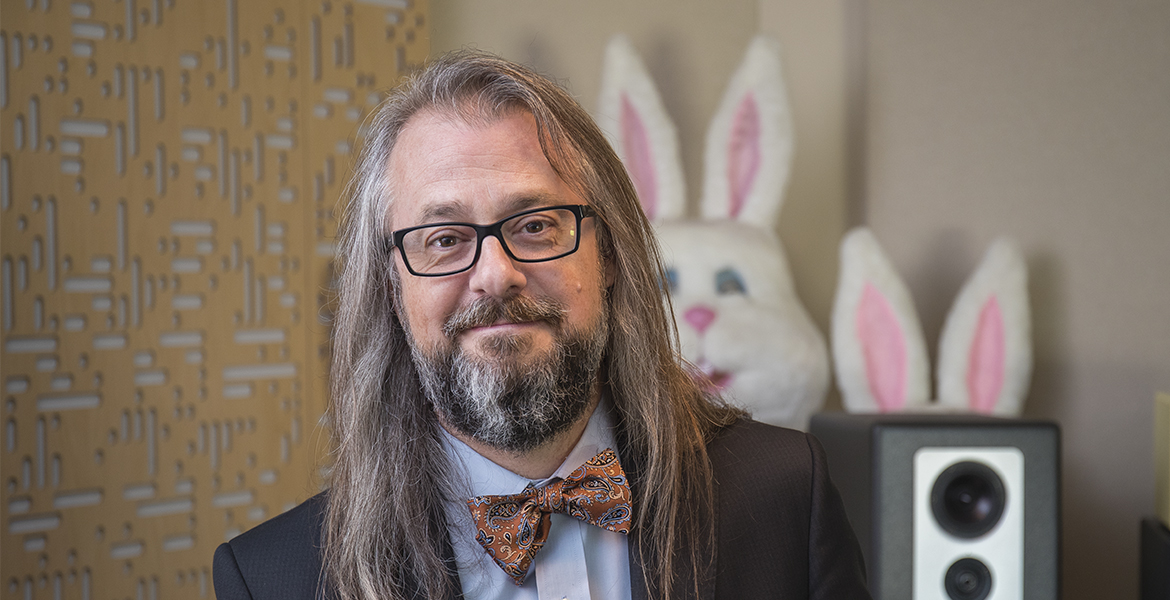
Finding the Beat
Friday, November 1, 2019
OSU’s Mark Perry brings the world of music to his students
There are branches of science where beakers are nonexistent and algorithms are few. For example, there’s ethnomusicology, where music is studied through the lens of anthropology, filtered through the culture that creates it. And there are professors who step out of the lecture hall, immerse themselves in research and bring in-depth expertise back to the classroom.
Dr. Mark Perry, director of the music industry program and assistant professor of ethnomusicology and historical musicology at Oklahoma State University, is known around the world for his research on musical cultures, electronic dance music (EDM) and its predecessor, disco. He’s also known by the moniker “thund3rbunny” for his work as a professional DJ, a side profession with applications in the classroom that also began as research.
Perry’s own career path included graduate degrees in classical guitar until a course with Bruno Nettl, renowned ethnomusicologist, changed his life. For his semester project for Nettl’s seminar on improvisation, Perry studied DJs. As a participant observer — someone who both observes and participates — he examined the craft from the point of view of the DJ and learned the art himself.
“I learned the tricks that get people to dance and to stop dancing. What DJs do is a form of composition in the course of performance. That is, the choice of records and the order you choose is a form of composition with the goal of getting people to dance.”
Perry is also multi-musical, meaning he has learned to perform the music of cultures other than his own.
“One of the tenets of ethnomusicology is that music is universal. There is music in every single society on the planet. Small or large, there is music,” he said. “But music is not a universal language. I study music within a particular cultural context.”
His large topic of study is electronic dance music. To understand EDM, Perry says it’s necessary to understand its origin in the disco era, which peaked in the 1970s. At the beginning of that decade, it was an underground music, associated with marginalized groups in society.
“It was the music of gay clubs, African American and Latino clubs in major cities,” he said.
Most of the successful, prominent disco singers were women. Perry said the female voice became the archetype of disco music, and since it was based on records and not live performance, it didn’t matter to those dancing who was singing. Perry presented his findings on the male falsetto voice in disco in Germany in June.
In the latter part of the ‘70s, thanks in part to movies like Saturday Night Fever (1977), disco became popular in the mainstream.
Its mainstream presence ultimately led to its downfall. Disco began taking a large market share from rock music, which was predominantly white, heterosexual and male. Rock stations began a revolt.
On July 12, 1979, disco’s demise as a mainstream player was most apparent at a Chicago White Sox doubleheader where tickets were discounted for anyone who brought a disco album to the stadium. Between games, shock jock Steve Dahl planned to blow up the records on the field in a “disco demolition.” A riot ensued, the field was damaged and the White Sox ended up forfeiting their second game.
“The music industry in the United States stopped using the label ‘disco,’” Perry said. “Part of this music went underground again.”
Once again, the music of the disenfranchised, disco evolved into electronic dance music. EDM has more than 100 subgenres — and Perry can identify them all.
“I travel to different parts of the world and do field work in dance clubs,” he said. “When I tell them, people always laugh. Trust me; sometimes it is work. As I get older, it is getting harder.”
Sunrise Chebahtah, a senior in the music industry program, believes Perry’s experiences around the world are invaluable for students.
“Because of all the things he has done, he is able to give such a wider perspective than what we will ever know. He’s been immersed, and it helps us in class to gain a respect for things we are learning about even though we don’t get to have that close proximity to it,” she said. “He always manages to make class interesting — something unique and memorable. That’s not to say the tests aren’t still hard because they’re ridiculous.”
Ashton Mainord is a sophomore in the music industry program as well. She was impressed with the diversity in electronic dance music.
“It’s not just everything you hear on the radio,” she said. “There are extensive differences in all of them, and I didn’t realize how diverse it was.”
Perry’s work benefits his students when he can apply his research to the music industry business.
“I have students who make beats,” he said. “My expertise in electronic dance music helps them with their beats. Because of the music industry degree, my research is made practical with application in the real world. Music informs the present, but also what they’re doing now is built on something else. It’s vital that students don’t ‘reinvent the wheel’ by wasting valuable time creating or inventing something that already exists — understanding the past and present is imperative and is applicable to songwriting, technology and music trends.”
